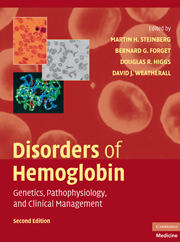Book contents
- Frontmatter
- Contents
- List of Contributors
- Foreword, by H. Franklin Bunn
- Preface
- Introduction, by David J. Weatherall
- SECTION ONE THE MOLECULAR, CELLULAR, AND GENETIC BASIS OF HEMOGLOBIN DISORDERS
- SECTION TWO PATHOPHYSIOLOGY OF HEMOGLOBIN AND ITS DISORDERS
- SECTION THREE α THALASSEMIA
- SECTION FOUR THE β THALASSEMIAS
- SECTION FIVE SICKLE CELL DISEASE
- SECTION SIX OTHER CLINICALLY IMPORTANT DISORDERS OF HEMOGLOBIN
- SECTION SEVEN SPECIAL TOPICS IN HEMOGLOBINOPATHIES
- SECTION EIGHT NEW APPROACHES TO THE TREATMENT OF HEMOGLOBINOPATHIES AND THALASSEMIA
- 29 Transfusion and Iron Chelation Therapy in Thalassemia and Sickle Cell Disease
- 30 Induction of Fetal Hemoglobin in the Treatment of Sickle Cell Disease and β Thalassemia
- 31 Novel Approaches to Treatment
- 32 Stem Cell Transplantation
- 33 Prospects for Gene Therapy of Sickle Cell Disease and Thalassemia
- Index
- Plate section
- References
29 - Transfusion and Iron Chelation Therapy in Thalassemia and Sickle Cell Disease
from SECTION EIGHT - NEW APPROACHES TO THE TREATMENT OF HEMOGLOBINOPATHIES AND THALASSEMIA
Published online by Cambridge University Press: 03 May 2010
- Frontmatter
- Contents
- List of Contributors
- Foreword, by H. Franklin Bunn
- Preface
- Introduction, by David J. Weatherall
- SECTION ONE THE MOLECULAR, CELLULAR, AND GENETIC BASIS OF HEMOGLOBIN DISORDERS
- SECTION TWO PATHOPHYSIOLOGY OF HEMOGLOBIN AND ITS DISORDERS
- SECTION THREE α THALASSEMIA
- SECTION FOUR THE β THALASSEMIAS
- SECTION FIVE SICKLE CELL DISEASE
- SECTION SIX OTHER CLINICALLY IMPORTANT DISORDERS OF HEMOGLOBIN
- SECTION SEVEN SPECIAL TOPICS IN HEMOGLOBINOPATHIES
- SECTION EIGHT NEW APPROACHES TO THE TREATMENT OF HEMOGLOBINOPATHIES AND THALASSEMIA
- 29 Transfusion and Iron Chelation Therapy in Thalassemia and Sickle Cell Disease
- 30 Induction of Fetal Hemoglobin in the Treatment of Sickle Cell Disease and β Thalassemia
- 31 Novel Approaches to Treatment
- 32 Stem Cell Transplantation
- 33 Prospects for Gene Therapy of Sickle Cell Disease and Thalassemia
- Index
- Plate section
- References
Summary
TRANSFUSION
Thalassemia Major (Cooley Anemia)
Eighty years ago, Dr. Thomas Cooley and his colleagues at the Children's Hospital of Michigan administered blood transfusions to children with a newly recognized clinical entity whose features included severe anemia, splenomegaly, and peculiar facies. Five years later, Cooley's name had become indelibly associated with the disease, and transfusions were administered along with ferrous carbonate, ultraviolet rays, and extract of pituitary gland. Not surprisingly, given the state of crossmatching at the time, the response to transfusion was poor. Another 30 years elapsed before improvements in blood banking and recognition of the benefits of a higher hemoglobin level came together to initiate the era of modern transfusion therapy for thalassemia major.
Transfusion Programs
In 1963, the results of an evaluation of 35 children with thalassemia major, aged 12 years or younger, whose pretransfusion hemoglobin levels fell into three categories – 4.0–5.9 g/dL, 6.0–7.9 g/dL, or 8.0–9.9 g/dL – were described. Children in the highest hemoglobin group had better linear growth, less enlargement of the liver and spleen, less facial and skull bony abnormalities, fewer fractures, and less cardiomegaly than children in the two lowest hemoglobin groups. Two patients who received regular red cell transfusions to maintain their hemoglobin level above 10 g/dL at all times were also reported. More than 40 years later, this regimen – hypertransfusion – remains the standard of care for the treatment of thalassemia major. General guidelines for hypertransfusion therapy are presented in Tables 29.1 and 2.
- Type
- Chapter
- Information
- Disorders of HemoglobinGenetics, Pathophysiology, and Clinical Management, pp. 689 - 744Publisher: Cambridge University PressPrint publication year: 2009
References
- 2
- Cited by



